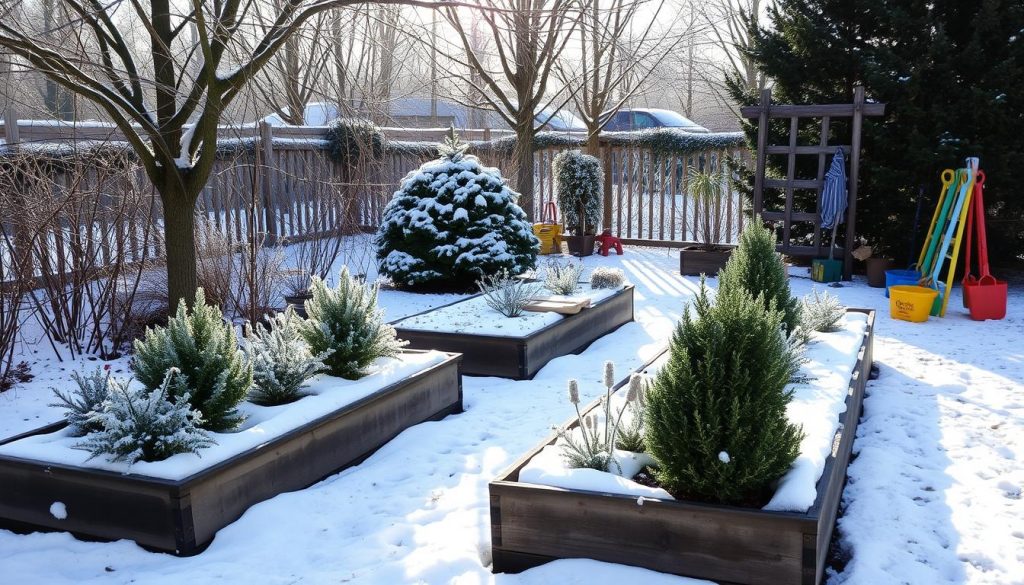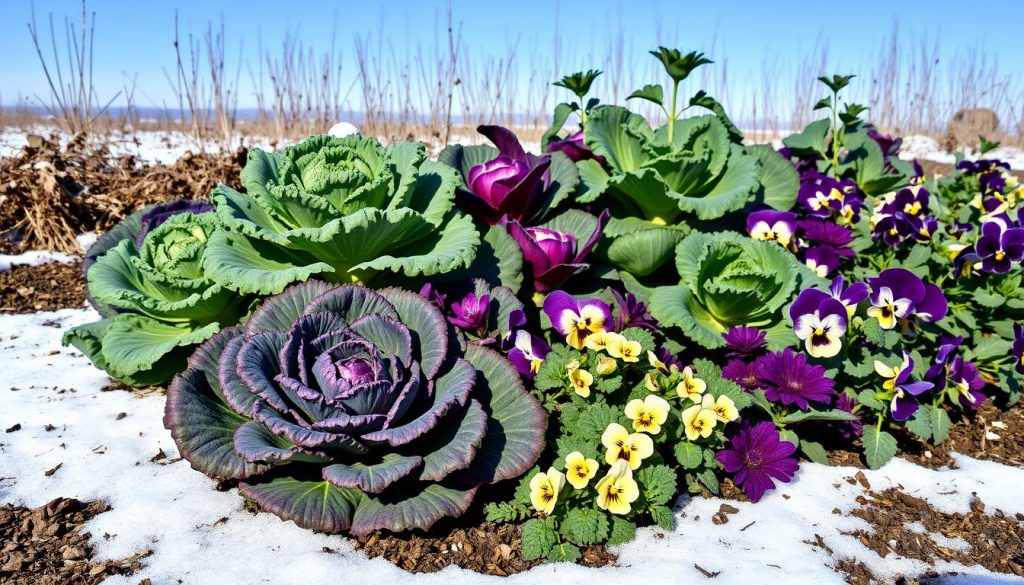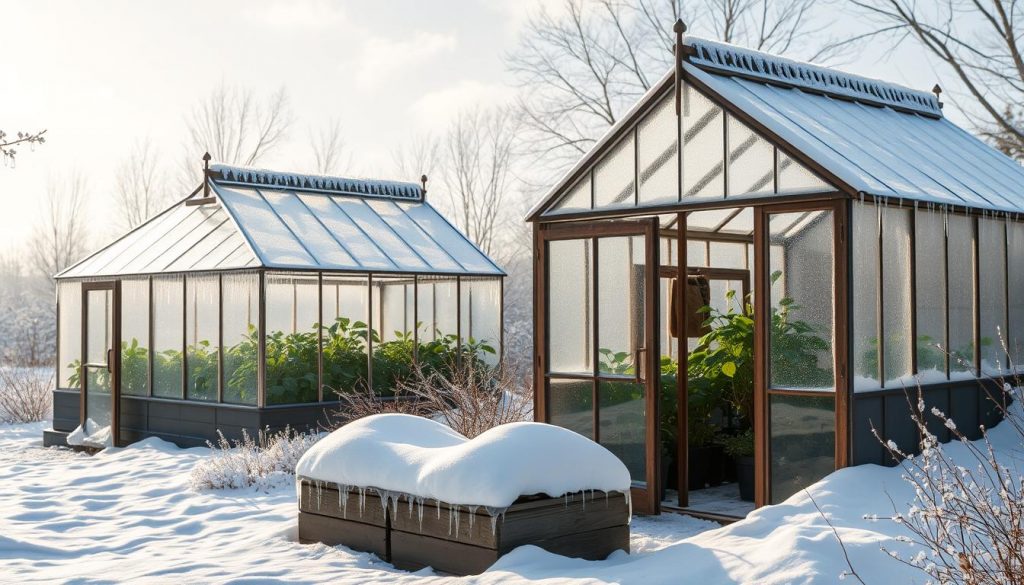Many have thought that when winter arrives it is time to tuck away all the gardening equipment. Still, it is not very difficult to make your garden survive and thrive by following the right approach. Knowing some of the best winter gardening practices enables one to have a fantastic winter garden.
Learn how to shield your plants from frost and choose varieties that can handle the cold. You’ll also find ways to make your growing season longer. Keep your garden lively and full of life all winter long.

Protecting Plants from Frost and Freezing Temperatures
Winter has here, and it’s time to preserve your plants. There are several strategies to protect your garden from frost and cold. One great method is winter mulching.
Mulching Techniques: Winter Gardening Tips
Putting a thick layer of mulch around your plants keeps them warm. It stops the soil from freezing. This keeps your plants safe and their roots healthy. Use organic stuff like leaves, straw, or bark. They keep warm, and as they break down, they make the soil better.
Covering Plants with Frost Blankets: Winter Gardening Tips
For plants that are easily hurt, use frost blankets or row covers. These fabrics keep cold out and let warmth in. Just remember to take them off during the day so plants get sunlight and air.
Using these easy insulating plants tips, your garden can still grow strong in winter. With some prep and the right winter mulch, your plants will do great next season.
Choosing Cold-Hardy Plants for Your Winter Garden
The first thing that has to be done to achieve a colorful winter garden is choosing the right plants. These plants have to be cold hardy. Fortunately, many plants are hardy and can be fine with cooler climates. Some of the hardy perennials and evergreen shrubs will be useful in improving the vigor and strength of your yard.
The Russian Sage is the best for this case. It can even withstand freezing weather conditions as well as drought like conditions. This plant can be grown in winter gardens because it can survive lows of up to negative 20 degrees F.
“Incorporating plants that thrive in cold weather is the secret to a lush and vibrant winter garden.”
The Winter Jasmine is another favorite. It’s a shrub that blooms yellow flowers in winter. Its long branches and delicate flowers bring warmth and beauty to any cold landscape.

Winter Gardening Tips: Extending the Growing Season
Gardeners looking to grow plants year-round can try building cold frames and greenhouses. These structures let you grow plants even in cold weather. They help you start growing early and keep growing all year.
Building a Cold Frame or Greenhouse: Winter Gardening Tips
Cold frames sit on the ground and trap heat to protect plants. Greenhouses are bigger and can be heated for growing all year. Both cold frames and greenhouses help extend the growing season and keep your garden thriving.

Choosing between a cold frame or a greenhouse depends on your space and needs. Make sure your structure gets lots of sun and is protected from strong winds. With the right design, your garden can be green all year.
Preparing Your Garden for Winter
It’s time to prepare your garden for winter when the seasons shift and the temperature decreases.Winterizing your garden requires a number of significant chores. These consist of cleaning, adding compost, pruning, and soil amendment. By completing these chores now, you may ensure that your plants survive and flourish come springtime.
Pruning and Cleaning Up
A thriving garden into the cold months depends on fall garden cleaning. Firstly, trim off any damaged or dead leaves. Next, clear away any fallen leaves or other debris. This keeps pests and illnesses out of your garden and maintains its aesthetic appeal.
Moreover, make sure to toss away any unhealthy or infected plant material. In addition, put it outside of your compost mound.
Composting and Soil Amendments
Along with cleaning, winter compost and soil prep are vital for preparing your garden for winter. Firstly, spread a layer of compost over your garden beds. Next, mix it gently into the soil. This improves soil structure and drainage and gives your plants nutrients for the spring.
Furthermore, if your soil needs lime or fertilizer, add them now. By properly preparing your garden for winter, you’re setting up for a great growing season. Ultimately, a bit of effort now will make your garden healthy and ready for spring.
Growing Vegetables Indoors During Winter
It shouldn’t be possible to enjoy fresh, homegrown vegetables throughout the winter months. Many vegetables may be grown inside, even in frigid climates. You can produce vegetables all year round, whether you have a specialized grow room or a sunny place.
Selecting appropriate cold-tolerant plants is essential for indoor winter gardening. Indoors, leafy vegetables like lettuce, kale, and spinach thrive. Root vegetables such as carrots, beets, and radishes thrive nicely inside. Fresh veggies may be enjoyed throughout the winter with appropriate care.

“Nothing beats the satisfaction of harvesting your own homegrown vegetables, even in the middle of winter.”
To start growing veggies indoors, set up a dedicated space with extra lighting. This could be LED or fluorescent bulbs. Make sure to water, control the temperature, and keep the air moving. These steps will help you enjoy fresh, tasty veggies all year, no matter the weather.
Caring for Houseplants in Winter
When it gets colder and the days are shorter, taking care of your houseplants is important. You need to water them right and keep the humidity up. This helps them stay healthy during the winter.
“The secret to keeping houseplants happy in winter is paying close attention to their water and humidity needs.”
By following these tips, you can keep your indoor plants healthy and looking good all winter long.
Overwintering Tender Bulbs and Perennials: Winter Gardening Tips
As autumn proceeds, it is very important to look after those fine bones and be conscious of all delicate lights. That way, they will survive the winter and be ready to flower the next April. These are plants that produce beautiful flowers year after year, and so they should be protected by taking steps which will not allow the pests to damage them.
Dahlias and canna lilies need to have their bulbs dug up before the first frost. Cut the foliage back and store in a cool dry place. They asleep last this way in the basement or garage till spring.
For less hardy perennials, such as lantana or fuchsias, mulch around the base to protect the roots. Potted plants can also be brought inside or taken to the greenhouse. This gives them added insulation againt the cold.
Winter care of plants is not same for all plants. Heartier perennials, like hostas or peonies, require little mulch. However, more delicate crops will require covering with a frost blanket or perhaps even just sheltering in a South facing aspect.
By preparing your plants for winter, you can ensure that they survive the cold and thrive in the spring. Your garden will then be filled with your favorite colors and textures.

Winter Garden Maintenance and Pest Control: Winter Gardening Tips
Keeping a winter garden healthy needs regular care, especially with snow and ice. Winter garden maintenance is key to protect your plants. It helps your garden stay healthy and productive even in cold weather.
Addressing Snow and Ice Buildup: Winter Gardening Tips
Managing snow and ice buildup is a big challenge in winter gardens. Clearing paths and removing snow from plants is essential. This prevents damage and keeps air moving.
Use strong garden tools like a snow shovel or brush to make clearing easier. Also, use de-icing products made for gardens to melt ice and avoid slippery spots.
It’s also crucial to watch for pests in your winter garden. Pests like rodents, birds, and insects can harm your plants. Use pest control methods like deterrents or organic solutions to keep your garden healthy.
“Maintaining a winter garden requires a proactive approach to address the unique challenges of the season, from snow and ice buildup to pest control. With the right techniques, you can ensure a healthy, productive garden all year round.”
Enjoying the Beauty of a Winter Garden: Winter Gardening Tips
Winter gardens can be a true delight, despite the cold. Furthermore, they offer a peaceful escape from daily life. By embracing winter gardening, you can enjoy the season’s natural wonders.
In addition, the frost-kissed foliage and bare trees create a serene beauty. Moreover, choosing cold-hardy plants and thoughtful design elements can make a winter oasis. Ultimately, this oasis celebrates the season’s beauty and offers a refreshing escape.
Additionally, admiring snow-covered landscapes or winter flowers can be meditative. In fact, a well-designed winter garden is a space to connect with nature. Overall, it shows us the beauty hidden in winter, even in its coldest moments.

